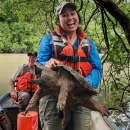The U.S. Fish and Wildlife Service proposes listing the alligator snapping turtle as threatened under the Endangered Species Act (ESA). The proposal follows a review of the best available science that indicates decades of overharvesting for domestic and international meat consumption, impacts from nest predation, recreational and illegal harvest and collection, and fishing activities are taking a severe toll on the turtle, which can grow up to 249 pounds.
Ongoing conservation measures the Service is undertaking on behalf of the alligator snapping turtle include captive rearing and release and habitat restoration and improvement. Tishomingo National Fish Hatchery in Oklahoma initiated a captive breeding program in 1999 to produce head-started alligator snapping turtles for reintroduction. The Natchitoches National Fish Hatchery in Louisiana has also begun a head-start program for the same purpose. In addition, the species is listed under the Convention on International Trade in Endangered Species (CITES) of Wild Fauna and Flora, an international agreement between governments designed to ensure trade in specimens of wild animals and plants does not threaten their survival.
Alligator snapping turtles get their name from large, powerful jaws and shells that can resemble the rough, ridged skin of an alligator. Adult males can weigh up to 249 pounds; females are much smaller. Known from 14 different states across the Southeast, Midwest and Southwest, the alligator snapping turtle is the largest freshwater turtle in North America.
Earlier this year, the Service proposed listing the Suwannee alligator snapping turtle, a closely related but separate species, as threatened under the ESA. The Suwannee alligator snapping turtle only occurs in the Suwannee River basin of Georgia and Florida.
A thorough scientific review of the status of the alligator snapping turtle was conducted by the Service through a Species Status Assessment (SSA), which reflects input from many partners and has been peer- and partner-reviewed. The SSA conducted for the alligator snapping turtle showed its populations are in decline and expected to continue to decline into the foreseeable future. Factors affecting the future viability of these turtles include legal and illegal harvest, drowning as a result of by-catch from recreational and commercial fishing, hook ingestion, habitat alteration and nest predation. Historically, commercial and recreational take in the 20th century resulted in significant declines to many alligator snapping turtle populations. Commercial harvesting of alligator snapping turtles that depleted populations in Louisiana, Florida, Georgia and Alabama is now prohibited in all states within its range. Recreational harvest continues in Louisiana and Mississippi but is prohibited in all other states where the species occurs. The SSA can be accessed at https://ecos.fws.gov/ServCat/.
The Service determined that designation of critical habitat for the alligator snapping turtle may be prudent but is not determinable at this time. In addition to seeking sufficient information to perform the required analyses for proposing critical habitat, the Service is also seeking comment on whether designation of critical habitat would contribute to further declines of the species by providing information on the turtles’ locations, making them vulnerable to take.
The Service will accept comments received or postmarked on or before January 10, 2022. Comments submitted electronically using the Federal eRulemaking Portal (http://www.regulations.gov must be must be received by 11:59 p.m. Eastern Time on the closing date. In the Search box, enter FWS–R4–ES–2021–0115, which is the docket number for this rulemaking.
If you suspect someone is illegally removing live alligator snapping turtles, or any other species, please call the Service’s wildlife trafficking tips line at 1-844-FWS-TIPS (397-8477) or email fws_tips@fws.gov. You might be eligible for a financial reward if your tip helps solve a case.





